A new desalination technology developed by power engineers at the Ural Federal University (UrFU) could considerably decrease the cost associated with water desalination and increase the production volume by four times.
 Alharbawi Naseer Tawfiq Alwan assembled a prototype of the distiller in the UrFU workshop. Image Credit: UrFU / Ilya Safarov.
Alharbawi Naseer Tawfiq Alwan assembled a prototype of the distiller in the UrFU workshop. Image Credit: UrFU / Ilya Safarov.
The outcomes of the study have been published in the Case Studies in Thermal Engineering journal.
One of the most famous and easy methods for water desalination at present is the distillation of water using solar energy. Researchers from UrFU, along with collaborators from Iraq, have come up with a hybrid technology to raise the efficiency of evaporation within a solar distiller through a solar collector and a rotating hollow cylinder.
We created a desalination technology by using a rotating hollow cylinder inside the solar distiller to accelerate water evaporation in the vessel by forming a thin film of water on the outer and inner surface of the cylinder, which is constantly renewed with each turn. To increase the temperature of water under the cylinder we use a solar collector.
Sergei Shcheklein, Head, Department of Nuclear Power Plants and Renewable Energy Sources, Ural Federal University
During the experiment, the cylinder’s rotation speed within the solar distiller was 0.5 rpm. This time and intensity are sufficient to evaporate a thin film of water from the surface of the cylinder.
For several months (June to October 2019), experimental tests were conducted in Ekaterinburg, Russia, and exhibited high reliability and efficiency of the developed device. Besides, the scientists observed that the comparatively low ambient air temperature and high intensity of solar radiation also boosted the water distillation performance.
The performance improvement factor of the created solar distiller, compared to traditional devices, was at least 280% in the relatively hot months (June, July, and August) and at least 300% and 400% in the cooler months (September and October). At the same time, the cumulative water distillation capacity reached 12.5 l/m2 per day in summer and 3.5 l/m2 per day in winter.
Alharbawi Naseer Tawfik Alwan, Research Engineer, Ural Federal University
Tawfik Alwan is also an employee of Northern Technical University, Iraq. The researchers believe that the affordable price and simple design of the newly developed desalination technology could gain interest in the Middle East and Africa—countries facing freshwater shortages but with high solar energy potential.
Later, researchers intend to enhance the technology and increase the performance of the solar distiller at the lowest possible capital and operating costs for various climatic conditions.
Journal Reference:
Alwari, N. T., et al. (2021) Evaluation of distilled water quality and production costs from a modified solar still integrated with an outdoor solar water heater. Case Studies in Thermal Engineering. doi.org/10.1016/j.csite.2021.101216.